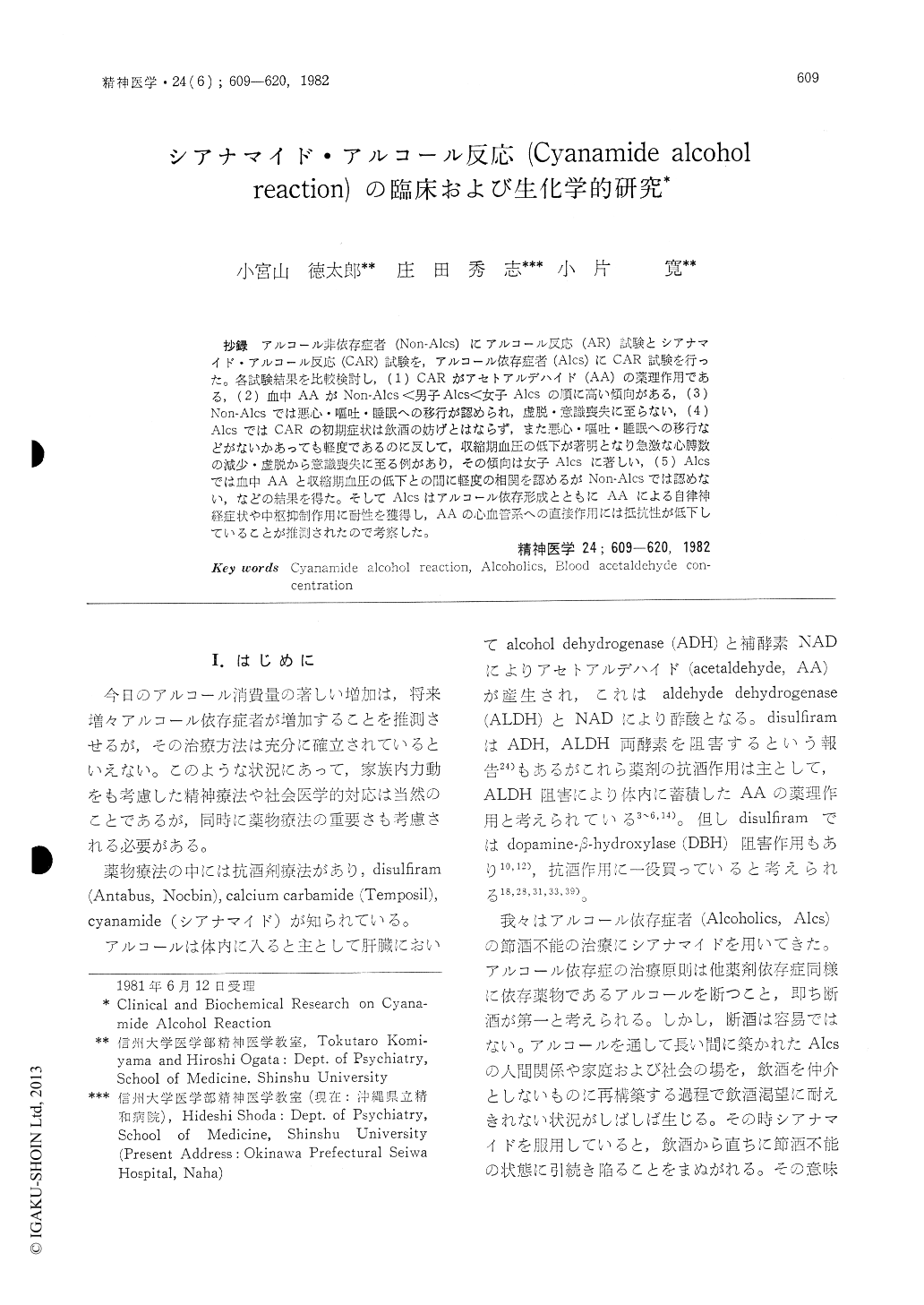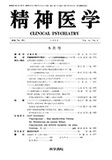Japanese
English
- 有料閲覧
- Abstract 文献概要
- 1ページ目 Look Inside
抄録 アルコール非依存症者(Non-Alcs)にアルコール反応(AR)試験とシアナイド・アルコール反応(CAR)試験を,アルコール依存症者(Alcs)にCAR試験を行った。各試験結果を比較検討し,(1)CARがアセトアルデハイド(AA)の薬理作用である,(2)血中AAがNon-Alcs<男子Alcs<女子Alcsの順に高い傾向がある,(3)Non-Alcsでは悪心・嘔吐・睡眠への移行が認められ,虚脱・意識喪失に至らない(4)AlcsではCARの初期症状は飲酒の妨げとはならず,また悪心・嘔吐・睡眠への移行などがないかあっても軽度であるのに反して,収縮期血圧の低下が著明となり急激な心膊数の減少・虚脱から意識喪失に至る例があり,その傾向は女子Alcsに著しい,(5)Alcsでは血中AAと収縮期血圧の低下との間に軽度の相関を認めるがNon-Alcsでは認めない,などの結果を得た。そしてAlcsはアルコール依存形成とともにAAによる自律神経症状や中枢抑制作用に耐性を獲得し,AAの心血管系への直接作用には抵抗性が低下していることが推測されたので考察した。
Cyanamide alcohol reaction (CAR) as a disulfiram alcohol reaction refers to the unpleasant symptoms experienced upon drinking an alcohol beverage after having previously ingested cyanamide. Cyanamide has been considered to inhibit the action of aldehyde dehydrogenase, and subsequently CAR may be due to the pharmacological action of accumulated acetaldehyde.
The purpose of the present study is to investigate the relationship between CAR and acetaldehyde accumulated in blood and to compare alcoholics with non-alcoholics with respect to CAR.
The subjects consisted of two groups, five non-alcoholics and nine alcoholics, the latter group including three women. Both the alcohol reaction test and CAR test were performed on non-alcoholics, while only the CAR test was carried out on alcoholics. Cyanamide was in 1.0% solution. For non-alcoholics the CAR test was duplicated with 3 ml and 5 ml doses of cyanamide solution. However, because he experienced severe reactions with 3 ml cyanamide, the CAR test with 5 ml cyanamide was not performed on one of the subjects. Alcoholic women were pretreated with 3-4 ml cyanamide and alcoholic men with 5 ml ; 7 ml cyanamide was given to one man who showed a resistance to CAR with only 5 ml. Alcohol was given in the form of Sake (a Japanese alcoholic beverage, Ca 15% v/v alcohol). Twenty ml of Sake was ingested during a five to ten minute period and total consumption of Sake was within 180 ml. The CAR test was discontinued when subjects felt it too hard to ingest any more Sake.
During the experiment, pulse rate and blood pressure were measured every ten minutes, and clinical symptoms were recorded time by time. Clinical observations included flushing, mood change, state of consciousness, hand tremor and autonomic nervous symptoms; palpitation, headache,. nausea, and vomiting. Prior to and every thirty minutes during the experiment, the blood specimens were taken from the elbow vein for the determination of blood ethanol and acetaldehyde concentration.
Results: (1) CAR was confirmed to be due to the pharmacological action of accumulated acetaldehyde.
(2) Maximal blood acetaldehyde concentration was successively higher in alcoholic women, alcoholic men, and non-alcoholics.
(3) Non-alcoholics were susceptible to nausea, vomiting and falling asleep, but they were tolerant to collapse and loss of consciousness.
(4) In alcoholics early CAR did not disturb Sake ingestion. They were rarely susceptible to nausea, vomiting and falling asleep. On the other hand, they were susceptible to a decrease in systolic blood pressure, and some alcoholics showed a decrease in pulse rate, collapsed or lost consciousness. Alcoholic women in particular suffered from severe cardiovascular depressant symptoms.
(5) In alcoholics, a slight correlation between the blood acetaldehyde concentration and decrease in systolic blood pressure was defined. On the other hand, this correlation was not distinct in non-alcoholics.
Conclusion: It was postulated in our discussion that in alcoholics, the tolerance to autonomic nervous symptoms and central nervous depressant effects by acetaldehyde might have increased and that the resistance to the depressant action of acetaldehyde on the cardiovascular system might have decreased through the process of alcohol dependence.

Copyright © 1982, Igaku-Shoin Ltd. All rights reserved.


